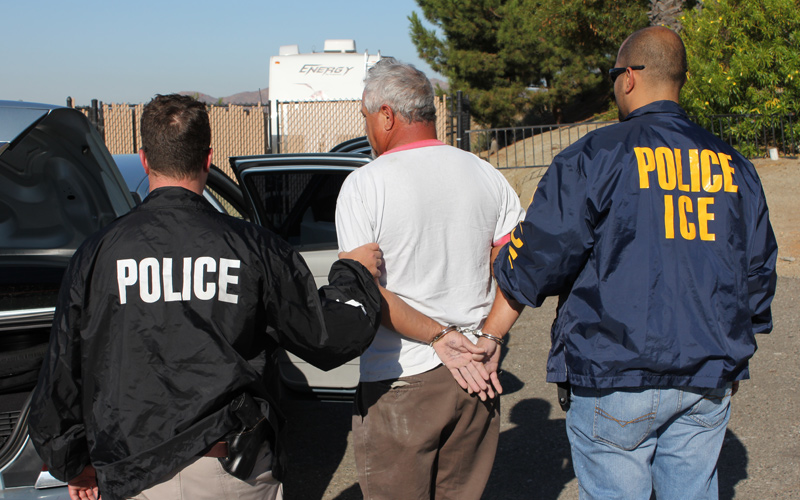By Anna Jarman

On
September 25, 2017, Georgetown University Law Center hosted the 14th
Annual Immigration Law and Policy Conference in partnership with the Migration
Policy Institute (MPI) and Catholic Legal Immigration Network, Inc. The conference addressed immigration policy
changes under the Trump administration, including the crack-down on “sanctuary
cities.”
Muzzafar
Chishti, director of MPI’s office in New York, moderated a discussion on sanctuary
cities and local law enforcement’s role in immigration with Hiroshi Motomura, a
law professor at the University of California, Los Angeles, School of Law;
Daron Hall, the Sheriff of Davidson County, Tennessee; and J. Thomas Manger,
the Chief of Police of Montgomery County, Maryland.
The Executive Order
Five days
after taking office, President Trump issued an executive order blocking federal
funding to “sanctuary cities” -- municipalities which restrict cooperation
between local law enforcement and federal immigration agents.
President
Trump’s stance on sanctuary cities fits neatly inside his “America First”
foreign policy, which he campaigned on and which has guided his administration
since he took office. President Trump
promised that he would put American workers first in all aspects of policy, whether
that was negotiating favorable trade agreements or ensuring that illegal
immigrants did not deprive American citizens of jobs, drain government benefits,
or threaten public safety.
Many
lawmakers, including President Trump, believe sanctuary cities threaten public
safety by allowing criminals who could have been deported to go free and commit
future crimes. Local law enforcement
officials counter that sanctuary measures are necessary to promote trust
between illegal immigrants and police.
Sanctuary Cities: Testing Issues of
Federalism
Motomura said
this standoff over sanctuary cities between federal law and local officials is
“testing issues of federalism.” Immigration
was, until recently, a federal issue.
However, the 1996 Illegal Immigration Reform and Immigrant
Responsibility Act began to involve state and local governments in immigration enforcement,
particularly through section 287(g) of the Act, which deputizes local law enforcement
personnel to enforce federal immigration law.
Some state
and local governments have also passed laws on immigration. For instance, Arizona passed S.B. 1070 which
made immigration offenses state crimes and empowered the police to make
warrantless arrests of aliens. In Arizona v. United States, the Supreme
Court held these provisions of S.B. 1070 preempted by federal law.
Motomura explained
that while Arizona reduced local governments’
power in immigration enforcement, it did not address the 10th
Amendment issues of coercion and deputizing local police that sanctuary cities
implicate. The Supreme Court has previously
held in Printz v. United States that
the federal government may not order local officials to enforce federal
law. Additionally, National Federation of Independent Business v. Sebelius, concerning
the Affordable Care Act, held that the government cannot use the threat of
large funding cuts to “coerce” states into adopting federally demanded
policies. Given the importance of these issues,
Motomura expects the federal government to weigh in on these issues as they continue
to pressure sanctuary cities.
Practical Issues of Enforcement:
Local Law Enforcement’s Perspective
The lack
of clarity surrounding law enforcement’s role in immigration enforcement
presents a great challenge to local law enforcement agencies, which find
themselves embroiled in a divisive political issue and faced with difficult
decisions about how best to police their communities.
Sheriff
Hall does not think immigration should be something he should be doing, but “since
the federal government doesn’t do a good job, [he has] to step in.” Under his leadership, Davidson County
eventually left the controversial 287(g) program. The program that replaced it, Secure
Communities, does not deputize local police but instead requires participating
jails to submit arrestee’s fingerprints to the U.S. Immigration and Customs
Enforcement’s (ICE) immigration database.
The problem with this approach, Sheriff Hall said, is that an arrestee’s
fingerprints will be identifiable only if he has already had an encounter with
ICE. This means that an undocumented
immigrant could have committed twenty crimes but remain unknown to ICE.
For both
Sheriff Hall and Chief Manger, the challenge is finding a balance between
public safety and limiting the harmful effects of deportations on individuals
and the community. Chief Manger worries
about the danger created when a portion of the population fears the police and won’t
come forward to report crimes or act as witnesses. In its attempt to strike the right balance, Montgomery
County does not comply when ICE asks the county jail to detain an illegal
immigrant until they can be taken into ICE custody, but does respond when ICE
inquires about individuals held in the county jail.



0 comments:
Post a Comment